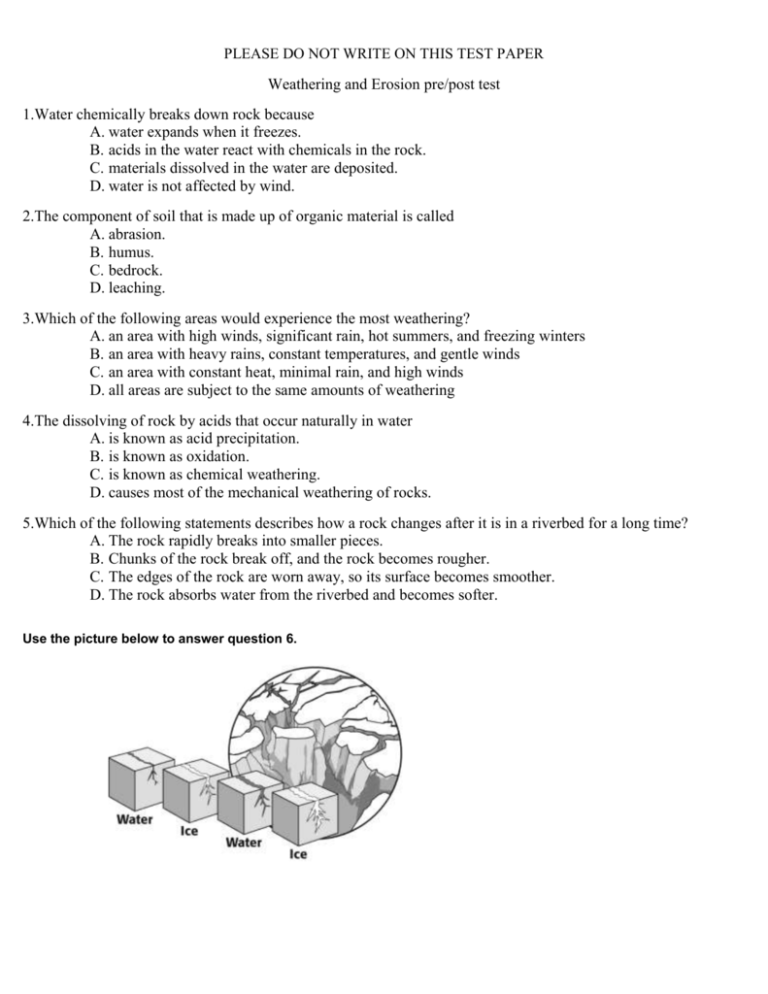PreTest – Post Test Weathering
advertisement

PLEASE DO NOT WRITE ON THIS TEST PAPER Weathering and Erosion pre/post test 1.Water chemically breaks down rock because A. water expands when it freezes. B. acids in the water react with chemicals in the rock. C. materials dissolved in the water are deposited. D. water is not affected by wind. 2.The component of soil that is made up of organic material is called A. abrasion. B. humus. C. bedrock. D. leaching. 3.Which of the following areas would experience the most weathering? A. an area with high winds, significant rain, hot summers, and freezing winters B. an area with heavy rains, constant temperatures, and gentle winds C. an area with constant heat, minimal rain, and high winds D. all areas are subject to the same amounts of weathering 4.The dissolving of rock by acids that occur naturally in water A. is known as acid precipitation. B. is known as oxidation. C. is known as chemical weathering. D. causes most of the mechanical weathering of rocks. 5.Which of the following statements describes how a rock changes after it is in a riverbed for a long time? A. The rock rapidly breaks into smaller pieces. B. Chunks of the rock break off, and the rock becomes rougher. C. The edges of the rock are worn away, so its surface becomes smoother. D. The rock absorbs water from the riverbed and becomes softer. Use the picture below to answer question 6. PLEASE DO NOT WRITE ON THIS TEST PAPER 6.The picture above shows the process of mechanical weathering that can cause cracks in rocks in Georgia’s northern mountains to widen. What is this process called? A. abrasion B. dissolution C. ice wedging D. oxidation 7.Why does air chemically weather rock? A. The air molecules are abrasive. B. Air fills cracks in the rock and later expands, causing the cracks to enlarge. C. The oxygen in the air combines with elements in the rock in a process called oxidation. D. The rock wears away after wind blows sand against the rock. 8.Which of the following is an everyday example of a chemical phenomenon? A. Fast moving river water rushes over rocks. B. Organic acids produced by lichens break down rock. C. Rocks tumble down a mountain during a rockslide. D. Ice forms in a crack in a rock and makes the crack larger. 9.Which human activities can help prevent soil erosion? A. planting cover crops and employing contour plowing methods B. strip mining and deforestation C. building cities and highways D. growing crops and burning fossil fuels Use the graph below to answer question 10. 10.Naomi made the pie graph above during a laboratory experiment in which she analyzed the composition of loam found in Georgia. Based on this chart, which of the following is a valid conclusion? A. Approximately 95% of the material that makes up loam is useless to plants. B. Decayed organic matter is the least abundant component of loam. C. Only about 9% of loam’s composition is useful to plants. D. Only about 16% of loam’s composition is useful to plants.








